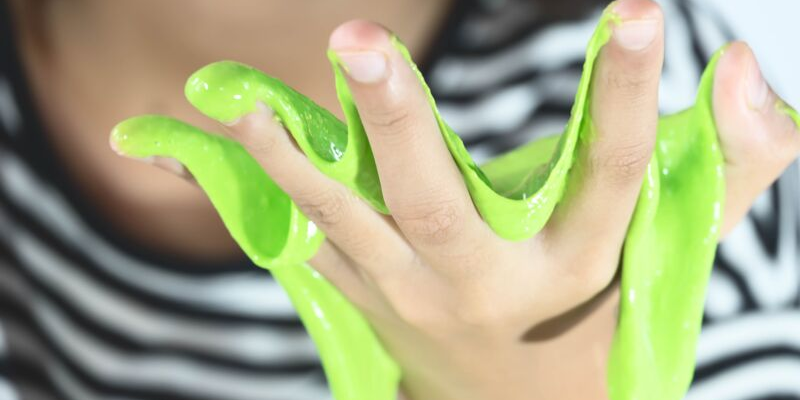Can Slime Cause a Rash on the Hands?

In the dermatology word, we have seen a sudden increase in hand rashes in kids who play with slime. Making slime at home using common household ingredients like school glue, borax, shaving cream, and contact lens solution has become very popular. In fact, the phrase “how to make slime” was the most-searched how-to question on Google in 2017.
However, the ingredients commonly used to make slime can cause a rash on children’s hands caused by an allergic reaction. This is known as contact dermatitis.
How Does Slime Cause Contact Dermatitis?
Contact dermatitis is the term used to describe what is usually a red, itchy rash that develops when the skin comes into contact with an allergen or irritant. A large number of materials and substances can cause contact dermatitis, including soap, laundry detergent, fragrance, dyes, and certain metals in jewelry.
Unfortunately, homemade slime contains several ingredients known to cause contact dermatitis. Detergents in shampoo and other ingredients used to make slime injure the skin barrier and allow allergens to enter the skin. Just some of the allergens in common slime ingredients include:
- Methylchloroisothiazolinone/methylisothiazolinone – found in school glue and hand soap
- Triethanolamine – found in shaving cream
- Ethylenediaminetetraacetic acid, ethylenediamine dihydrochloride, and polyaminopropyl biguanide – found in contact lens solution
- Fragrances
- Preservatives
In a 2018 case study, a 10-year-old girl reported having a pink, itchy rash on her hands for 1.5 years. Topical treatments prescribed by her dermatologist did not clear up the rash. However, her hands came into contact with homemade slime daily. A patch test showed strong reactions to methylchloroisothiazolinone/methylisothiazolinone, triethanolamine, ethylenediaminetetraacetic acid, ethylenediamine dihydrochloride, and polyaminopropyl biguanide. The patient was instructed to wear gloves when handling slime. Two months later, her rash was completely gone.
Interestingly, researchers from this study explained that the Centers for Disease Control and Prevention performed a separate study (data unavailable) found that methylchloroisothiazolinone and methylisothiazolinone are present in five of six school glues that were tested:
- Crayola Washable Glue
- Elmer’s X-Treme School Glue
- Aleene’s School Tacky Glue
- Aleene’s Clear School Tacky Glue
- Up & Up Washable School Glue
Elmer’s School Glue was the only tested product that did not contain these ingredients.
What to Do If Your Child Develops a Rash from Slime
If you suspect your child has developed a rash on his or her hands from playing with slime, immediately discontinue play with the slime, or make sure your child wears gloves when handling slime. Consult your dermatologist for treatment advice. He or she may also recommend a patch test, depending on the severity of the rash. Symptoms should subside once all contact with the irritants is discontinued.
Keep in mind that methylchloroisothiazolinone, methylisothiazolinone, and other ingredients used to make slime are also found in many other household products, including soap, shampoo, conditioner, detergent, makeup, and perfume. If your child develops a rash on other areas of his or her body and/or does not make slime, consider that these common products could be the culprit.
In Summary
Despite being labeled as “washable” or “for school,” many glues contain ingredients that are known to cause contact dermatitis. If your child makes slime, have him or her wear gloves when touching it and try to choose products that are free of irritants.
To stay up-to-date on the latest skincare news, tips, and advice from Dr. Leslie Baumann, be sure to follow us on Facebook, Instagram, and YouTube!
©2019 Metabeauty, Inc.


